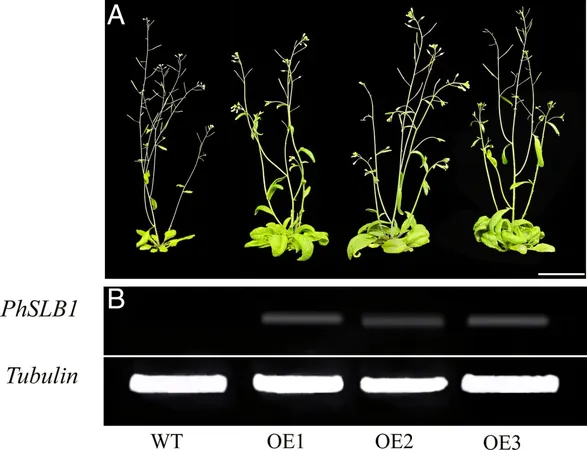
Unlocking Petunia's Growth Secrets: The Role of the PhSLB1 Gene in Branch Development
2025-03-26
Author: Wei Ling
In a groundbreaking study published recently, researchers have revealed that the gene PhSLB1 is integral to regulating branch development in petunia (Petunia hybrida). This discovery not only sheds light on plant growth mechanisms but also opens new avenues for horticultural practices and strategies for crop improvement.
Branching is a key factor in the overall structure of plants, significantly influencing biomass production, flowering potential, and yield outcomes. The study investigates how PhSLB1 impacts the growth and development of petunia, focusing on its role in the regulation of shoot branching.
The architecture of a plant—encompassing traits such as height, number of branches, and branch angles—plays a vital role in the agronomic characteristics of horticultural crops. This is especially true for ornamental plants, where the number of branches can drastically affect aesthetic appeal and consumer choices. Branching occurs when meristematic tissue at the leaf axil forms axillary buds, which can then develop into lateral branches. This intricate process is controlled by a mix of genetic factors, environmental influences, and plant hormones.
Through comprehensive molecular and genetic investigations, the research team has confirmed that PhSLB1 is a critical player in the modulation of branch formation. The gene operates by interacting with key signaling pathways that drive the initiation and outgrowth of lateral branches. These findings not only enhance our understanding of plant adaptability in response to environmental changes but also illustrate how growth is finely tuned at the molecular level.
The implications of this research extend beyond theoretical knowledge—there are significant benefits for both the horticulture and agriculture sectors. By harnessing the power of PhSLB1 and its associated signaling pathways, growers can potentially improve the structural attributes of petunias and other horticultural varieties. This could lead to plants that not only boast greater aesthetic appeal but also exhibit improved resource efficiency and higher productivity.
Furthermore, as industries increasingly seek sustainable practices, knowledge about genetic regulation at this level could pave the way for cultivating plants that require fewer resources while still delivering outstanding results. The future of horticulture might very well hinge on the manipulation of genes like PhSLB1, making this an exciting time for both researchers and growers alike.



 Brasil (PT)
Brasil (PT)
 Canada (EN)
Canada (EN)
 Chile (ES)
Chile (ES)
 Česko (CS)
Česko (CS)
 대한민국 (KO)
대한민국 (KO)
 España (ES)
España (ES)
 France (FR)
France (FR)
 Hong Kong (EN)
Hong Kong (EN)
 Italia (IT)
Italia (IT)
 日本 (JA)
日本 (JA)
 Magyarország (HU)
Magyarország (HU)
 Norge (NO)
Norge (NO)
 Polska (PL)
Polska (PL)
 Schweiz (DE)
Schweiz (DE)
 Singapore (EN)
Singapore (EN)
 Sverige (SV)
Sverige (SV)
 Suomi (FI)
Suomi (FI)
 Türkiye (TR)
Türkiye (TR)
 الإمارات العربية المتحدة (AR)
الإمارات العربية المتحدة (AR)